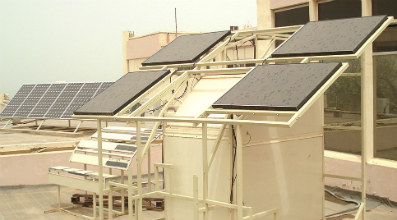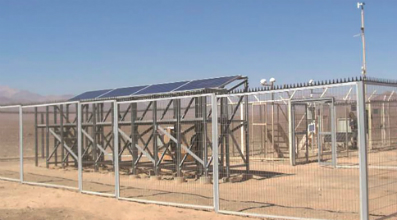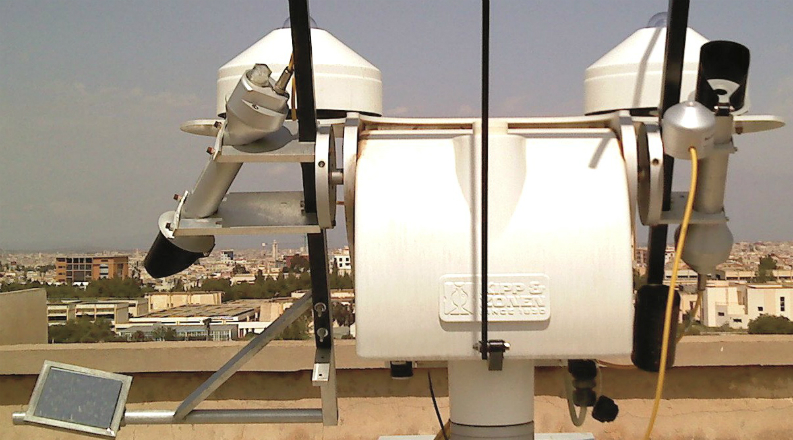In such areas soiling by dust and sand is a serious issue that affects the efficiency of the plant and understanding it is crucial for the whole process of calculating the viability of a project. Soiling-related issues need to be studied to understand output losses, schedule maintenance, calculate life-cycles of components and evaluate bankability.
Soiling is a complex process that strongly depends on the local environment. Surface conditions, wind patterns, humidity and the temperature of the air are the main natural parameters that affect soiling. Anthropogenic factors also play important roles; agricultural activities, traffic and air pollution contribute to deposition of dust and pollutants on PV panels, CPV lenses and CSP plant mirrors.

The causes of soiling
In solar energy projects the main contributors to soiling are the following:
- Dust, pollen, sand and other airborne particles naturally accumulate on the surfaces of PV modules, concentrating mirrors and lenses. This reduces the energy output of solar plants, particularly those located in arid areas with agricultural activities and loose soil.
- Airborne pollutants such as vapors, smog, and soot can form a surface layer that is harder to clean than dust or sand. This is especially relevant in urban and industrial areas.
- Deposition of sand and dust in arid areas can be increased by night dew as the dust and sand sticks to wet surfaces. During the day the dust dries out and is baked on by the sun and the next night more accumulates on the dew-damp surface. The process repeats, forming a thick layer of dust that can completely block the light.
- Dirt often accumulates on the lower part of PV panels that have a raised mounting frame, providing partial shading and reducing the efficient area of the PV module. This is especially relevant in areas close to the equator as the panels are usually installed with low tilt angles to receive the maximum amount of solar radiation during the day.
- Mould can grow on the surface of PV panels in warm and wet areas. The heat accumulated during the day and the humidity during night-time provide ideal conditions for microorganisms to proliferate and form an opaque layer on the surface of PV modules.
- Bird droppings (guano) in some locations can be sufficient to provide partial blocking of cells in modules. This affects the current flow in the modules and usually causes a drop of efficiency of the module or of a complete string. It also affects the efficiency of mirrors.
The relative significance of the various contributors to soiling at any given location will vary throughout the year due to the local climate and weather processes.
How soiling is measured
Soiling can be estimated in a number of ways, depending upon the required precision and the practical application. As it is hard to estimate soiling theoretically, due to its local and variable nature, a number of empirical methods are used by researchers and solar plant operators.
In smaller projects the effect of soiling is often estimated by using a reference PV cell or module that is subject to the same environment as the rest of the installation. The output of the module is compared to the expected theoretical reference output and the soiling rate is calculated. This method separates the measurements of the efficiency of the plant from the soiling measurements to provide independent data for analysis. However, it can miss the influence of several variable parameters such as the available irradiance, degradation of the modules, and the effects of temperature and wind.
Prospecting of new sites before deciding to embark upon a large scale commercial solar park requires a more comprehensive study of potential soiling issues. Such a study needs to take into account several aspects; differences between soiling rates on PV modules with different tilt angles, varying PV technology characteristics, effectiveness of anti-soiling coatings, efficiency of cleaning methods, soiling of concentrating mirrors for CSP plants, etc.
The variation in effects at different times of the year are very important for calculating the return on investment of future projects and need to be monitored. For such studies researchers use specially designed scientific stations that monitor soiling, solar radiation and meteorological parameters.
In the Atacama Desert in Chile, Patricia Darez, the Energy Analysis Group Manager of Mainstream Renewable Power, uses an experimental soiling monitoring station which includes measurement of the electrical output of four panels with different cleaning patterns, as well as using an anti-soiling coating to study its efficiency. The station includes two CMP 11 pyranometers one horizontal and one tilted, ventilated with the CVF 3. This pioneering research provides an understanding into the conditions in this remote region, which is not yet well modelled but has very high potential for solar development.

Mainstream Renewable Power soiling research station in the Atacama Desert
In Kuwait irradiance levels are high and soiling is being studied by Dr. Hassan Qasem, a research scientist at the Energy and Building Technologies Department of the Kuwait Institute for Scientific Research (KISR). The research is based on laboratory testing of dust samples’ physical and optical properties as well as on outdoor testing. To monitor irradiance and weather conditions a meteorological station is installed at the site.
The station includes two CMP 11 pyranometers (to measure horizontal and tilted global irradiance), wind speed and direction, ambient temperature, relative humidity, precipitation and a data logger.
Soiling is especially critical for CPV and CSP projects as these work by focusing the direct beam of light from the sun. Researchers from the German Aerospace Center (DLR) and the Mohamed Premier University in Oujda, Morocco in collaboration with CSP Services and Plataforma Solar de Almeria studied the soiling levels of concentrating solar power mirrors. This resulted in a system called TraCS (Tracking Cleanliness Sensor) that compares the direct normal irradiance (DNI) measured by a reference CHP 1 pyrheliometer mounted on an automatic sun tracker to the output of a second CHP 1 pyrheliometer mounted on the same SOLYS 2 sun tracker and aimed at a mirror so that it sees the reflection of the sun.

A TraCS system measures the soiling effects on mirror reflectivity in real-time
The various methods of measuring soiling have one thing in common; they use high quality instruments for reliable studies. A good monitoring system that is properly maintained will lead to reducing the losses resulting from soiling and other environmental parameters and will improve the return on investment of solar energy projects.